The Radio Shack Model 4 High-Resolution Board
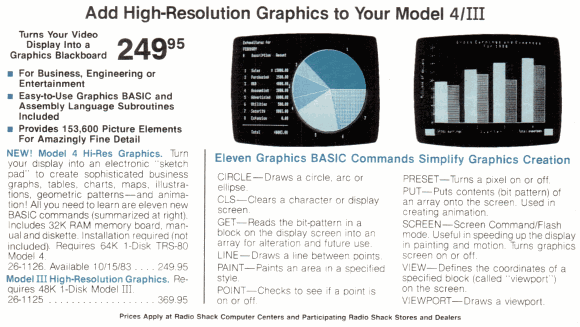
Model 4 high-resolution board from a 1984 Radio Shack catalog
Radio Shack introduced their high-resolution add-on for the Model 4 (catalog number 26-1126) on October 15, 1983. Just like their Model III high-resolution board, it was never identified by name in any Radio Shack catalog. The official name seems to have been “TRS-80 Model 4 Computer Graphics” but it was usually referred to as the “Radio Shack Model 4 high-resolution board.”
At $249.95, the Model 4 high-resolution board was $80 cheaper than the Model III version. It provided a nearly identical hardware interface as the Model III version, with the same 640 by 240 resolution. It’s interesting to note that the Macintosh screen at the time was 576 by 340.
Unlike the Model III high-resolution board, the Model 4 high-resolution board used the video controller (a Motorola 6845) already present in the Model 4. Curiously, many of the included programs still attempted to reprogram the controller, even though the documentation clearly stated this was not necessary. That controller reprogramming code even showed up in some programs generated by BASCOM, the Microsoft BASIC Compiler.
Unlike the Model III, the Model 4 was designed with a high-resolution graphics connector on the motherboard. This made installation of the high-resolution board far easier but Radio Shack still required installation by a technician.
The Model 4 high-resolution board came with the same utilities as the Model III version and BASICG, the graphics BASIC, had the same commands. The high-resolution board was also compatible with most graphical programs written for the Model 4 Grafyx Solution by Micro-Labs. The Grafyx Solution was a competing high-resolution board that was cheaper, user installable, and far more popular among Model 4 users.
Probably the most impressive features of the Model 4 high-resolution board weren’t documented at all. It supported three undocumented ports that allowed programs to:
- offset the display in either direction, to simulate hardware scrolling
- mix text and graphics on screen
- disable wait states for a faster (if hash filled) display
No reason was ever given as to why these ports existed or why they were never documented. They weren’t present in the Model III version, but as far as I know, no one ever found a Model 4 board that didn’t support them.
Because of the dominance of the Model 4 Grafyx Solution (which didn’t support the undocumented ports), not many Model 4 programs used the extra features. One notable example was the VT-100 terminal program ANSITERM by Richard VanHouten, which used the undocumented ports (if present) for enhanced scrolling.
The price of the Model 4 high-resolution board was reduced to $219.95 by 1986. There were reports that high-resolution would be included as a standard feature when the Model 4D was introduced in 1987, but those rumors proved to be baseless.
The Model 4 high-resolution board remained in the Radio Shack catalog until 1990.
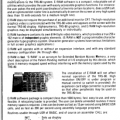
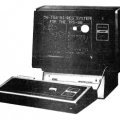
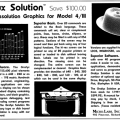
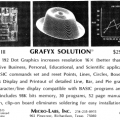










Lamar Owen says:
Minor correction and documentation note: the extra ports are fully documented in the Model 4P Service Manual, page 189 (page 181 on most of the PDF’s out there). The 4P service manual includes the board layout and schematics, as well as the gate array chip’s high-level block diagram and the PAL equations for the one PAL on the board.